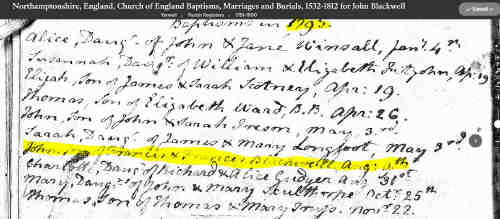John BLACKWELL [1319] 2330
- Born: 1795, , Northamptonshire, England 2430
- Christened: 7 Aug 1795, Nassington, Northamptonshire, England 2430
- Marriage (1): Ruth CLARKE [1318] on 19 Aug 1817 in Wilby, Northamptonshire, England 2422,2423
- Died: 1 Feb 1870, Higham Ferrers, Northamptonshire, England at age 75 2431,2432
- Buried: 5 Feb 1870, Blessed Virgin Anglican, Higham Ferrers, Northamptonshire, England 2433,2434
 Another name for John was John BLACK. Another name for John was John BLACK.
 Find a Grave ID: 198639418. WikiTree ID: Blackwell-2376. Find a Grave ID: 198639418. WikiTree ID: Blackwell-2376.

 General Notes: General Notes:
NOTE: DEC 2023: I have found a John Blackwell baptised 09 Aug 1795 at Yarwell, Northamptonshire, son of Francis and Frances Blackwell (nee Barker), who is a very likely candidate to be this John Blackwell. I have added them to the DNA tree but I am awaiting confirmation via DNA as to whether they are the likely parents of this John or whether this is not our John's parents at all. John Blackwell and Ruth Clarke were married at Wilby. Francis and Frances Blackwell also had a son Francis who was also married at Wilby a few years after John and Ruth were married there, this has reinforced my thinking that Francis and Frances may be John's biological parents. Francis Jnr and his wife lived in the Earls Barton area until their deaths.
12 Dec 2023: Today I have woken to find several DNA matches with Geoff Blackwell and other descendants of Francis and Frances Blackwell, proving my theory to be 100% correct. It's party time after 40 years to find them at last.
BIOGRAPHY:
John's birth is estimated to be about 1796. All records including death and censuses, indicate birth between 1792-1802. His occupation was shoemaker.
All the children of John and Ruth were christened under the surname of Black, which is why they had not been found. Jan Dabson supplied me with christening details from registers she has in her possession. I have since confirmed all the christening details supplied by Jan.
A Mary Fisher was in attendance at the death of John Blackwell.
John and Ruth's three adult children who died after compulsory registration was introduced, died of Tuberculosis. Tuberculosis is a bacterial infection of the lungs and sometimes other parts of the body, and is spread by droplets in the coughs or sneezes of a person with the disease. Tuberculosis was known as 'consumption' in the 19th century and was a major cause of death in Britain at that time. The disease is still common where there is overcrowding, malnourishment and poor health care.
Tuberculosis, also known as "consumption," "phthisis," or the "white plague," was the cause of more deaths in industrialized countries than any other disease during the 19th and early 20th centuries. By the late 19th century, 70 to 90% of the urban populations of Europe and North America were infected with the TB bacillus, and about 80% of those individuals who developed active tuberculosis died of it.
For most of the 19th century, tuberculosis was thought to be a hereditary, constitutional disease rather than a contagious one. By the end of the 19th century, when infection rates in some cities were thought by public health officials to be nearly 100%, tuberculosis was also considered to be a sign of poverty or an inevitable outcome of the process of industrial civilization. About 40% of working-class deaths in cities were from tuberculosis.
Robert Koch's identification of the tuberculosis bacillus in 1882 helped to convince members of the medical and public-health communities that the disease was contagious. Preventing the spread of tuberculosis became the motivation for some of the first large-scale public health campaigns.
Mortality rates began declining in the late 19th century throughout Europe and the United States. Whether sanitary measures, sanatoria, improved nutrition, or larger epidemiological factors unrelated to human intervention were the cause of this decline remains undecided. ocp.hul.harvard.edu/contagion/tuberculosis.html
In 1870-72, John Marius Wilson's Imperial Gazetteer of England and Wales described Higham Ferrers like this:
HIGHAM-FERRERS, a small town, a parish, a subdistrict, and a hundred in Northamptonshire. The town stands on a rocky height, near the river Nene and the Northhampton and Peterborough railway, 3 miles from the boundary with Beds, and 15½ ENE of Northhampton. It was known, at Domesday, as Higham; and it took its after name from the Earls Ferrers, who were its lords. Its site has yielded relics which show it to have been probably occupied by the Romans; and is within 3 miles of the Roman station of Chester.

 Noted events in his life were: Noted events in his life were:
1. Residence: High Street, 1841, Higham Ferrers, Northamptonshire, England. 2435
2. Residence: 6 Newland Street, 1851, Higham Ferrers, Northamptonshire, England. 2436 Occupation cordwainer.
3. Residence, 1861, Higham Ferrers, Northamptonshire, England. 2437
4. Burial information: Blessed Virgin Anglican, 5 Feb 1870, Higham Ferrers, Northamptonshire, England. 2438

John married Ruth CLARKE [1318] [MRIN: 408], daughter of William CLARKE [7530] and Mary ROGERS [7531], on 19 Aug 1817 in Wilby, Northamptonshire, England 2422.,2423 (Ruth CLARKE [1318] was born about 1798 in Earls Barton, Northamptonshire, England, christened on 8 Jun 1813 in Earls Barton, Northamptonshire, England,2335 died on 9 Jul 1871 in Higham Ferrers, Northamptonshire, England 2424,2425 and was buried on 11 Jul 1871 in Blessed Virgin Anglican, Higham Ferrers, Northamptonshire, England 2426,2427.)
|

 Another name for John was John BLACK.
Another name for John was John BLACK.